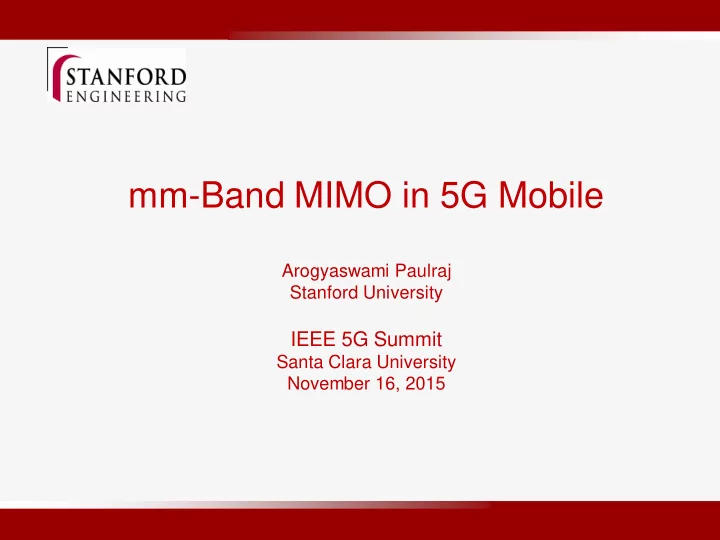

mm-Band MIMO in 5G Mobile Arogyaswami Paulraj Stanford University IEEE 5G Summit Santa Clara University November 16, 2015
Service Vision and Performance Low Power Universal Connectivity Low Latency Immersive Experience High Reliability Tele-Control, Tactile, V2X High Speed
Technologies SDN Multi-RAT Dense Cells WiFi Integration Virtualization MTC Support U-, C – Plane Splitting Multi-Link Integration CA Het-Net D2D CoMP ICIC SRAN Multi-Service Platforms mm-Band MIMO Multiple Access, Waveforms Modulation
mm-Band MIMO Multiple Access, Waveforms and Modulation Spatial Modes
Large MIMO • Antennas – BS 100 to 10,000 ! – Large number of RF chains, PAs – UE 2 - 8 • BS Beam widths – 10 to 1 deg • Channel BW 500 - 1500 MHz • Use of LOS – MIMO • U-plane carrier, Data Only • Main access mode - MU-MIMO • Back / Front Haul P2P Modes
mm-Band • Proposed US Bands – 28, 37, 39, 57 - 71 GHz • Propagation mode – Generally LOS, but NLOS also present, strong shadowing, stronger fading – No significant loss in free space (outside 60 GHz) – but foliage and precipitation induce losses • Deployment – Small cells ~ 150m – High BS antennas • Green !
Some History • Iospan Wireless (1998) built a Broadband Wireless Internet system. Acq. by Intel in 2003 • Married MIMO & OFDM (DS-SS was then reigning waveform) • Iospan Technology – Cellular architecture (nomadic access, layer 3 hand over) – CP-OFDM, MIMO (2 streams) and M-QAM with Rep. Coding, OFDMA, STC, …. • Iospan technology became precursor for WiMAX (2005) and adopted by LTE (2009) and WiFi 11n (2009)
Why OFDM + MIMO ? Channel Spreading Waveform Tiling Time Pre-MIMO Waveforms designed to be orthogonal in one dimension and equalized in the other dimension (per user)
Why OFDM + MIMO ? Post-MIMO Space Time H(f,t) Spatial dimension is inherently non-orthogonal, so strict orthogonality preferred in Freq. and Time - > CP-OFDM
4G Waveforms • CP-OFDM – Sub-Carriers were Freq. Flat and Orthogonal > Great for MIMO, MIMO decoding can be done per sub-carrier – Pain Points - High PAPR, Guard Time (CP), Guard Band, Out of Band Emission, Strict c lock and time Sync. on UL, … • WiMAX and WiFi stayed with OFDM • LTE modified UL to DFT - OFDM to reduce PAPR Ch. BW CP
5G Waveform Candidates • BW < 100 MHz current OFDM LTE is OK • BW > 100 MHz < 1000 MHz – OFDM needs some changes • BW > 1000 MHz, OFDM not attractive Trade Offs OFDM for > 100 MHz < 1000 MHz • Time Orthogonality • FBMC – Filter Bank Multi Carrier • Freq. Orthogonality • UFMC - Universally Filtered Multi • Out of Band Emission Carrier • MIMO friendly • f-OFDM - Spectrum Filtered OFDM • UL Synchronization • GFDM – Generalized FDM • Flexible Raster (Windowing Choices)
5G Waveforms BW > 1000 MHz • Single Carrier (SC) seems more attractive • OFDM’s high PAPR complicates high rate ADC / DACs, SC is low PAPR • OFDM’s PAPR also complicates low power / efficient PA design for large arrays • Low delay spread of narrow mm-Band beams makes SC equalization manageable. Freq. domain turbo equalization • SC waveforms – Constant Envelop, Continuous Phase, Linear (QAM) …
Modulation • 4G • 5G (< 6 GHz) • • M-QAM for high SNRs and M-QAM at high SNR and FSK Repetition Coding (RC) for low at low SNR SNRs • Encode N + 2 bits by choosing one of 2 N sub carriers and 4- • RC is not energy efficient at low SNR (cell edge) and also QAM modulation on the increases PAPR for chosen sub carrier narrowband UL (IoT)
Multiple Access 5G (< 6 GHz) 4G • Time-Frequency - Quasi • Time-Frequency - Strict Ortho Ortho – SCMA (Sparse Coded UE1 MA) (overloading and spreading) UE2 – QOMA (Quasi Ortho. UE3 Mul. Access a.k.a NOMA) UE4 ~ SP coding with power allocation to exploit path loss differences, SIC Rx • Space • Space Single User - Quasi Ortho QO-MIMO - Quasi Ortho Multi User - Strict Ortho DL for Multi User DL also
MIMO Modes • Vertical Dimension (FD – MIMO) • Single User (streams limited by UE antennas) • Multi User (streams limited by BS antennas and power) LOS • Distributed Multi User LOS
Interference Management • Inter BS interference is localized along beam / sector axis, no collision - no interference • Avoid interference collision by inter-BS coordination (topological interference alignment) • Inter-sector and inter user interference can be handled by SIC Rx and NAIC (Network Assist IC)
Large MIMO – Pragmatism • Grouped analog front end with DAC CODEC reduced digital Tx, Rx (hybrid DAC front ends) • Adaptive sectorizaton to DAC separate UE clusters followed with per sector MIMO processing • Low BPS/Hz waveforms to tolerate MU interference, poor channel estimates. Low PAPR • Also ML and SIC Rx to handle multi-user interference (QO- MIMO)
Channel Estimation - Pilots • Pilots confined to sector • UL – Easy, pilot overhead depends on UE antennas • DL – Hard, pilot overhead depends on BS antennas • TDD – needs expensive calibration • Model based channel estimation in sparse scattering environments – Array calibration manageable • Exploit sparsity in all dimensions
Summary Large MIMO, mm-Band propagation, large BW and small cell size changes the existing LTE design tradeoffs on waveforms, multiple access, modulation, RF architecture, interference management and MIMO modes Hardware integration with 2,3 and 4G (Soft RAN) Many open issues!
Recommend
More recommend